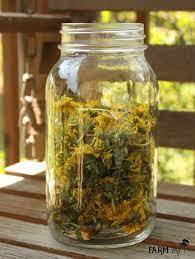Dandelions are one of the most misunderstood plants out there. While considered a nuisance by many gardeners, they pack a powerful punch of vitamins A and C, calcium and iron. 5 Reasons Why Dandelion Plants Aren’t Always a Bad Thing.
They are also an important early season food source for pollinators and the puffy seeds can make for a fun wish. So why is it so hard to love this little weed?

They’re Food for Beneficial Bugs
Aside from being a rich source of beta-carotene, dandelion plants are a staple food for many beneficial insects and pollinators. They are also an important early blooming flower that provides a source of nectar for honey bees before other flowers become available.
Their deep tap roots help improve the quality of soil in your garden, bringing up nutrients to the surface for the grasses and other plants. And they can take root in even the most compacted, hard soil.
As the season progresses, dandelion flowers produce one-seeded fruits with the seed wall fused to the fruit body (like sunflowers), which develops into a parachutelike structure that helps disperse the seeds. And if you catch a dandelion seed head on the wind, you can always blow on it and make a wish! -Jennifer Lester, freelance writer and social media strategist
They Aerate the Soil
Many of the same traits that make dandelions hard to remove also give them benefits to your garden. For example, dandelion roots dig deep into the ground and loosen compacted soil. This aerates the soil and allows plants to better access nutrients, as well as helps prevent erosion.
They also help create drainage pathways in dense soil, making them a valuable addition to a garden. This is especially important for vegetable gardens that can become flooded with water or puddling.
The dandelion’s seed head also functions like a parachute, and with the right wind can disperse seeds up to 60 yards away. That is why kids love it so much. It is the only flower they can pick without getting in trouble, and they have fun blowing on them to tell if their crush likes them back or to see how many of the seeds will fall off in one breath.
They’re Pretty to Look at
Dandelion flowers are a welcome sight in any lawn, especially after a long, gray winter. They grow in a rosette of sharply toothed leaves 6-12 in. long, topped by yellow blossoms and airy puffball seed heads that resemble lion’s teeth—a connection that explains why the French term dent de lion (“lion’s tooth”) became the name we use today for this plant.
Their roots are also excellent soil aerators, and their lengthy taproots help break up compacted earth.
Unlike many other plants we consider to be “weeds,” the dandelion is actually quite nutritious. Its nutrient-rich leaves provide vitamins A, C and K, plus potassium, iron and calcium.
They’re a Natural Weed Killer
Despite being a pesky nuisance for many gardeners, the dandelion (Taraxacum officinale) is chock-full of vitamins A, B, C, and D, as well as minerals like iron and potassium.
Dandelion is an easy-to-spot plant with bright yellow flower heads that appear singly on the tips of leafless, hollow stems in lawns and other open areas. It is a perennial in most climates and grows year-round. The name “dandelion” comes from the French ‘dent de lion,’ which refers to the shape of its leaves with jagged edges and deep lobes that resemble a lion’s tooth.
Dandelion leaves are a powerhouse of vitamin A and C as well as a good source of potassium, iron, and calcium. Try tossing them in your salad or sauteing them with garlic and olive oil needs read more hear.



















